Eastern Cicada Killer: Difference between revisions
No edit summary |
|||
| (43 intermediate revisions by the same user not shown) | |||
| Line 2: | Line 2: | ||
|+ !colspan="2" style="min-width:12em; text-align: center; background-color: rgb(235,235,210)|'''Eastern Cicada Killer | |+ !colspan="2" style="min-width:12em; text-align: center; background-color: rgb(235,235,210)|'''Eastern Cicada Killer | ||
|- | |- | ||
| [[File:Cicada-killer.jpg]] | | [[File:Cicada-killer.jpg | [https://www.flapest.com/pest-info/bees-wasps-and-hornets/cicada-killer-wasp/]]] | ||
|- | |- | ||
!style="min-width:6em; |Kingdom: | !style="min-width:6em; |Kingdom: | ||
| Line 11: | Line 11: | ||
|- | |- | ||
!style="min-width:6em; |Class: | !style="min-width:6em; |Class: | ||
|style="min-width:6em; |Insecta | |style="min-width:6em; |[[Insects | Insecta]] | ||
|- | |- | ||
!style="min-width:6em; |Order: | !style="min-width:6em; |Order: | ||
|style="min-width:6em; |Hymenoptera | |style="min-width:6em; |[[Hymenoptera]] | ||
|- | |- | ||
!style="min-width:6em; |Family: | !style="min-width:6em; |Family: | ||
| Line 28: | Line 28: | ||
== Description == | == Description == | ||
The Eastern Cicada Killer ( | The Eastern Cicada Killer (Sphecius speciosus) is a large, solitary digger wasp belonging to the Crabronidae family. It is one of the largest wasp species in North America. Adults can range from 1.5 cm to 5 cm in length, with females typically being larger than males<ref name= "Coelho">Coelho, J.R. 1998. “(PDF) An Acoustical and Physiological Analysis of Buzzing in Cicada Killer Wasps (Sphecius Speciosus ).” ResearchGate, July. https://doi.org/10.1007/s003590050297.</ref>. The abdomen is banded yellow and black, giving them a similar appearance to yellowjackets and other wasps. Their wings are large, brown-colored, and translucent. The eyes are quite large and reddish-brown in color. Eastern Cicada Killers have six legs that can range in color from yellow to red. Both female and male abdomens end in a tip, giving the appearance of a stinger, but only females actually possess a functional sting. | ||
[[File:Cicada Killer Wasp MF.jpg|frame|center | Male vs Female Eastern Cicada Killer]] | |||
== Habitat and Range == | |||
[[File:Eastern-Cicada_Killer-Range.png|frame|right| [https://bugguide.net/node/view/514/data US Range of Eastern Cicada Killer<ref name= "Bug Guide">“Species Sphecius Speciosus - Eastern Cicada-Killer Wasp.” n.d. Accessed March 31, 2025. https://bugguide.net/node/view/514/data..</ref>]]] | |||
Eastern Cicada Killers can be found throughout eastern North America<ref name= "Bug Guide">“Species Sphecius Speciosus - Eastern Cicada-Killer Wasp.” n.d. Accessed March 31, 2025. https://bugguide.net/node/view/514/data..</ref>. They prefer well-drained, loose, [[sand | sandy]] [[Soil | soils]] on southward-facing slopes for digging their nesting burrows. These nests may be located in forests or grasslands, as well as in more urban settings such as parks and gardens. The wasp prefers bare [[soil]] that is typically exposed to sunlight for optimal burrow placement. These burrows can be 25 cm to 50 cm deep and are typically 1.5 cm wide. The nests created within may contain multiple cells that serve as nurseries, with females capable of supporting up to 16 larvae in a single nest<ref name= "Gibb">Gibb, Timothy. 2018. “Cicada Killers.” March 2018. https://extension.entm.purdue.edu/publications/E-254/E-254.html.</ref>. | |||
[[File:Eastern Cicada Killer wasp nest.png | frame | center | [https://sites.tufts.edu/pollinators/tag/cicada-killer/ Cicada Killer Burrow<ref name= "burrow">“Cicada Killer,” August 13, 2020. https://sites.tufts.edu/pollinators/tag/cicada-killer/..</ref>]]] | |||
== Behavior and Life Cycle == | |||
[[File:Cicada-killer-with-insect.jpg |1000px| thumb|right | [https://pamlico.ces.ncsu.edu/2024/08/cicada-killer-wasp/ Cicada caught by Eastern Cicada Killer<ref name= "with cicada">“Cicada Killer Wasps,” August 13, 2024. https://pamlico.ces.ncsu.edu/2024/08/cicada-killer-wasp/..</ref>]]] | |||
The Eastern Cicada Killer is a solitary wasp and does not form large hives like bees or hornets. Males can sometimes be seen in groups; however, this is due to their highly territorial nature and competition for space. Males will attempt to court any females within their territory, and if successful, the two will mate. After mating, the female begins to search for a spot to burrow and create a nest. Multiple females can use a single burrow while maintaining their own individual cells within it. | |||
Adult Cicada Killers do not actually eat [[cicadas]]; their main food source is nectar from flowers. These wasps get their name from their parasitic larval stage. Once the nest is complete and prepared for larvae, the female ventures out to find a cicada. Upon finding one, she uses her stinger to paralyze the cicada and then carries it back to her burrow. Females are capable of catching and stinging cicadas midair, which is a remarkable feat considering cicadas are typically much larger than the wasps. The live cicada is stored in one of the nest’s cells, where the female Cicada Killer lays an egg on it before sealing the cell. Female eggs have been observed to sometimes receive two cicadas in a single cell, as they require more energy due to their size<ref name= "Coelho/Joseph">Coelho, Joseph R. 1997. “Sexual Size Dimorphism and Flight Behavior in Cicada Killers, Sphecius Speciosus.” Oikos 79 (2): 371–75. https://doi.org/10.2307/3546021..</ref>. | |||
The eggs hatch within 2 to 3 days, at which point the larvae burrow into the still-living cicada and begin to consume its internal organs. The [[cicadas |cicada]] must remain alive as long as possible, as spoilage could be fatal to the larvae<ref name= "Holliday">Holliday. 2014. “Biology of Cicada Killer Wasps | Prof. Chuck Holliday’s Www Page at Lafayette College.” October 22, 2014. http://web.archive.org/web/20141022032916/http://sites.lafayette.edu/hollidac/research/biology-of-cicada-killer-wasps/.</ref>. After feeding, the larvae spin a cocoon, in which they remain throughout the winter, spending 10–12 months underground<ref name= "Gist">Gist, Kelson. n.d. “Sphecius Speciosus (Cicada Killer).” Animal [[Diversity]] Web. Accessed March 31, 2025. https://animaldiversity.org/accounts/Sphecius_speciosus/.</ref>. Around mid-July, adults begin to emerge from the burrows. Males emerge first to compete over territory and prepare for mating before the females arrive <ref name= "Carlton">Carlton, Christopher E. 2024. “Sphecius Speciosus, Eastern Cicada Killer (Hymenoptera: Crabronidae).” LSU AgCenter. February 16, 2024. https://www.lsuagcenter.com/profiles/madeleinestout/articles/page1685734764096.</ref>. Females usually emerge a week or two later, at which point mating begins. Once mated, a female will not mate again and will start building a burrow for her nest. Males die shortly after mating, while females die after laying their eggs<ref name= "Holliday">Holliday. 2014. “Biology of Cicada Killer Wasps | Prof. Chuck Holliday’s Www Page at Lafayette College.” October 22, 2014. http://web.archive.org/web/20141022032916/http://sites.lafayette.edu/hollidac/research/biology-of-cicada-killer-wasps/.</ref>. By mid-September, most of the adult population has died, leaving their larvae underground to repeat the cycle the following July. Each year marks a completely new generation of Eastern Cicada Killers. | |||
Eastern Cicada Killers pose no threat to humans. Unlike eusocial [[hymenoptera | hymenopterans]], they do not sting to defend their nests. Males patrol their territories and are often drawn to any movement, which can be intimidating due to their large size and loud buzzing. They may hover around or even land on a person, which can appear aggressive. However, females rarely sting unless handled roughly, and males have no stinger at all. | |||
== Ecological Role == | |||
Eastern Cicada Killers play multiple roles within an ecosystem. Firstly, they can act as a natural control on cicada populations in forests. Cicadas can cause damage to deciduous trees when their populations grow too large, as female cicadas lay their eggs in tree branches. Eastern Cicada Killers rely exclusively on cicadas for their reproductive cycle, and their predation helps prevent cicada populations from reaching levels that could harm the larger ecosystem. In addition to population control, Eastern Cicada Killers also act as pollinators, feeding on flower nectar and inadvertently transferring pollen as it sticks to their bodies. They are also a host species for the [[Red Velvet Ant]] <ref name= "MO DEC">Missouri Department of Conservation. n.d. “Eastern Cicada-Killer Wasp.” Missouri Department of Conservation. Accessed March 31, 2025. https://mdc.mo.gov/discover-nature/field-guide/eastern-cicada-killer-wasp.</ref>. | |||
[[File:Cicada-killer-on-flower.jpg | frame | left|[https://www.inaturalist.org/observations/128505647 Eastern Cicada Killer on flower<ref name= "flower">Coghlan, Elisa. “Eastern Cicada-Killer Wasp (Sphecius Speciosus).” iNaturalist. iNaturalist, July 29, 2022. https://www.inaturalist.org/observations/128505647..</ref> ]]][[File:Cicada Killer.jpg | frame |right | [https://entomology.ca.uky.edu/ef004 Eastern Cicada Killer carrying cicada<ref name= "Carrying">“Cicada Killer Wasps | Entomology.” Accessed May 2, 2025. https://entomology.ca.uky.edu/ef004..</ref>]]] [[File:Red Velvet Ant.jpg | frame | center | [https://texasinsects.tamu.edu/red-velvet-ant-or-cow-killer/ Red Velvet Ant]]] | |||
== | == References == | ||
Eastern Cicada | <ref name= "Carlton">Carlton, Christopher E. 2024. “Sphecius Speciosus, Eastern Cicada Killer (Hymenoptera: Crabronidae).” LSU AgCenter. February 16, 2024. https://www.lsuagcenter.com/profiles/madeleinestout/articles/page1685734764096.</ref> | ||
<ref name= "Coelho/Joseph">Coelho, Joseph R. 1997. “Sexual Size Dimorphism and Flight Behavior in Cicada Killers, Sphecius Speciosus.” Oikos 79 (2): 371–75. https://doi.org/10.2307/3546021..</ref> | |||
<ref name= "Coelho">Coelho, J.R. 1998. “(PDF) An Acoustical and Physiological Analysis of Buzzing in Cicada Killer Wasps (Sphecius Speciosus ).” ResearchGate, July. https://doi.org/10.1007/s003590050297.</ref> | |||
<ref name= "MO DEC">Missouri Department of Conservation. n.d. “Eastern Cicada-Killer Wasp.” Missouri Department of Conservation. Accessed March 31, 2025. https://mdc.mo.gov/discover-nature/field-guide/eastern-cicada-killer-wasp.</ref> | |||
<ref name= "Gibb">Gibb, Timothy. 2018. “Cicada Killers.” March 2018. https://extension.entm.purdue.edu/publications/E-254/E-254.html.</ref> | |||
<ref name= "Gist">Gist, Kelson. n.d. “Sphecius Speciosus (Cicada Killer).” Animal [[Diversity]] Web. Accessed March 31, 2025. https://animaldiversity.org/accounts/Sphecius_speciosus/.</ref> | |||
<ref name= "Holliday">Holliday. 2014. “Biology of Cicada Killer Wasps | Prof. Chuck Holliday’s Www Page at Lafayette College.” October 22, 2014. http://web.archive.org/web/20141022032916/http://sites.lafayette.edu/hollidac/research/biology-of-cicada-killer-wasps/.</ref> | |||
<ref name= "Bug Guide">“Species Sphecius Speciosus - Eastern Cicada-Killer Wasp.” n.d. Accessed March 31, 2025. https://bugguide.net/node/view/514/data..</ref> | |||
<ref name= "Carrying">“Cicada Killer Wasps | Entomology.” Accessed May 2, 2025. https://entomology.ca.uky.edu/ef004..</ref> | |||
<ref name= "flower">Coghlan, Elisa. “Eastern Cicada-Killer Wasp (Sphecius Speciosus).” iNaturalist. iNaturalist, July 29, 2022. https://www.inaturalist.org/observations/128505647..</ref> | |||
<ref name= "with cicada">“Cicada Killer Wasps,” August 13, 2024. https://pamlico.ces.ncsu.edu/2024/08/cicada-killer-wasp/..</ref> | |||
<ref name= "burrow">“Cicada Killer,” August 13, 2020. https://sites.tufts.edu/pollinators/tag/cicada-killer/..</ref> | |||
Latest revision as of 13:46, 2 May 2025
![[1]](/images/3/3e/Cicada-killer.jpg)
| |
| Kingdom: | Animalia |
|---|---|
| Phylum: | Arthropoda |
| Class: | Insecta |
| Order: | Hymenoptera |
| Family: | Crabronidae |
| Genus: | Sphecius |
| Species: | Sphecius Speciosus |
Description
The Eastern Cicada Killer (Sphecius speciosus) is a large, solitary digger wasp belonging to the Crabronidae family. It is one of the largest wasp species in North America. Adults can range from 1.5 cm to 5 cm in length, with females typically being larger than males[1]. The abdomen is banded yellow and black, giving them a similar appearance to yellowjackets and other wasps. Their wings are large, brown-colored, and translucent. The eyes are quite large and reddish-brown in color. Eastern Cicada Killers have six legs that can range in color from yellow to red. Both female and male abdomens end in a tip, giving the appearance of a stinger, but only females actually possess a functional sting.
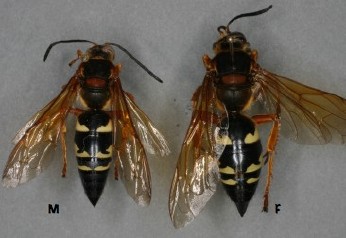
Habitat and Range
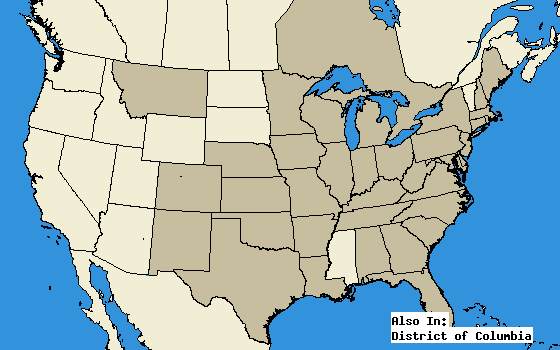
Eastern Cicada Killers can be found throughout eastern North America[2]. They prefer well-drained, loose, sandy soils on southward-facing slopes for digging their nesting burrows. These nests may be located in forests or grasslands, as well as in more urban settings such as parks and gardens. The wasp prefers bare soil that is typically exposed to sunlight for optimal burrow placement. These burrows can be 25 cm to 50 cm deep and are typically 1.5 cm wide. The nests created within may contain multiple cells that serve as nurseries, with females capable of supporting up to 16 larvae in a single nest[3].
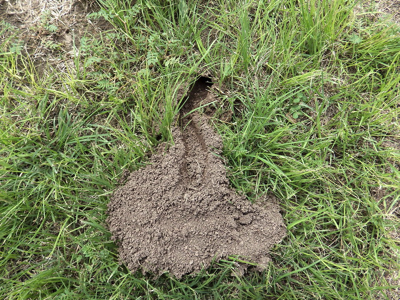
Behavior and Life Cycle
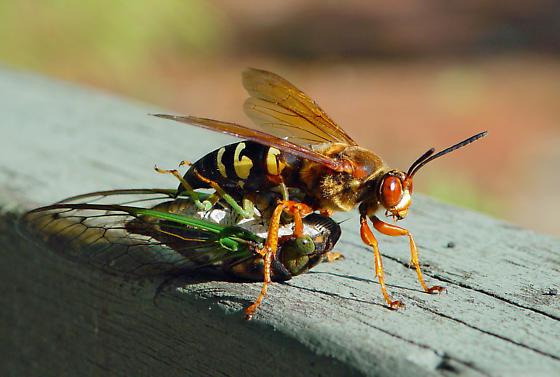
The Eastern Cicada Killer is a solitary wasp and does not form large hives like bees or hornets. Males can sometimes be seen in groups; however, this is due to their highly territorial nature and competition for space. Males will attempt to court any females within their territory, and if successful, the two will mate. After mating, the female begins to search for a spot to burrow and create a nest. Multiple females can use a single burrow while maintaining their own individual cells within it. Adult Cicada Killers do not actually eat cicadas; their main food source is nectar from flowers. These wasps get their name from their parasitic larval stage. Once the nest is complete and prepared for larvae, the female ventures out to find a cicada. Upon finding one, she uses her stinger to paralyze the cicada and then carries it back to her burrow. Females are capable of catching and stinging cicadas midair, which is a remarkable feat considering cicadas are typically much larger than the wasps. The live cicada is stored in one of the nest’s cells, where the female Cicada Killer lays an egg on it before sealing the cell. Female eggs have been observed to sometimes receive two cicadas in a single cell, as they require more energy due to their size[6].
The eggs hatch within 2 to 3 days, at which point the larvae burrow into the still-living cicada and begin to consume its internal organs. The cicada must remain alive as long as possible, as spoilage could be fatal to the larvae[7]. After feeding, the larvae spin a cocoon, in which they remain throughout the winter, spending 10–12 months underground[8]. Around mid-July, adults begin to emerge from the burrows. Males emerge first to compete over territory and prepare for mating before the females arrive [9]. Females usually emerge a week or two later, at which point mating begins. Once mated, a female will not mate again and will start building a burrow for her nest. Males die shortly after mating, while females die after laying their eggs[7]. By mid-September, most of the adult population has died, leaving their larvae underground to repeat the cycle the following July. Each year marks a completely new generation of Eastern Cicada Killers.
Eastern Cicada Killers pose no threat to humans. Unlike eusocial hymenopterans, they do not sting to defend their nests. Males patrol their territories and are often drawn to any movement, which can be intimidating due to their large size and loud buzzing. They may hover around or even land on a person, which can appear aggressive. However, females rarely sting unless handled roughly, and males have no stinger at all.
Ecological Role
Eastern Cicada Killers play multiple roles within an ecosystem. Firstly, they can act as a natural control on cicada populations in forests. Cicadas can cause damage to deciduous trees when their populations grow too large, as female cicadas lay their eggs in tree branches. Eastern Cicada Killers rely exclusively on cicadas for their reproductive cycle, and their predation helps prevent cicada populations from reaching levels that could harm the larger ecosystem. In addition to population control, Eastern Cicada Killers also act as pollinators, feeding on flower nectar and inadvertently transferring pollen as it sticks to their bodies. They are also a host species for the Red Velvet Ant [10].
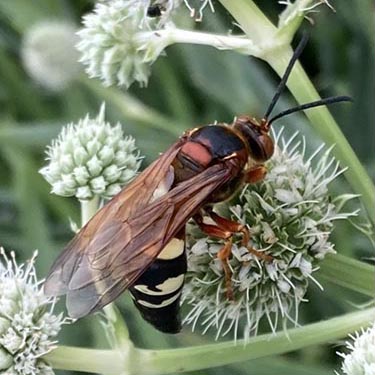
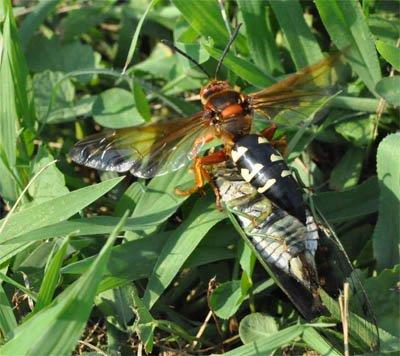
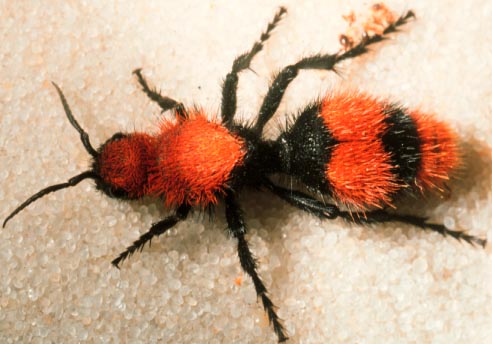
References
[9] [6] [1] [10] [3] [8] [7] [2] [12] [11] [5] [4]
- ↑ 1.0 1.1 Coelho, J.R. 1998. “(PDF) An Acoustical and Physiological Analysis of Buzzing in Cicada Killer Wasps (Sphecius Speciosus ).” ResearchGate, July. https://doi.org/10.1007/s003590050297.
- ↑ 2.0 2.1 2.2 “Species Sphecius Speciosus - Eastern Cicada-Killer Wasp.” n.d. Accessed March 31, 2025. https://bugguide.net/node/view/514/data..
- ↑ 3.0 3.1 Gibb, Timothy. 2018. “Cicada Killers.” March 2018. https://extension.entm.purdue.edu/publications/E-254/E-254.html.
- ↑ 4.0 4.1 “Cicada Killer,” August 13, 2020. https://sites.tufts.edu/pollinators/tag/cicada-killer/..
- ↑ 5.0 5.1 “Cicada Killer Wasps,” August 13, 2024. https://pamlico.ces.ncsu.edu/2024/08/cicada-killer-wasp/..
- ↑ 6.0 6.1 Coelho, Joseph R. 1997. “Sexual Size Dimorphism and Flight Behavior in Cicada Killers, Sphecius Speciosus.” Oikos 79 (2): 371–75. https://doi.org/10.2307/3546021..
- ↑ 7.0 7.1 7.2 Holliday. 2014. “Biology of Cicada Killer Wasps | Prof. Chuck Holliday’s Www Page at Lafayette College.” October 22, 2014. http://web.archive.org/web/20141022032916/http://sites.lafayette.edu/hollidac/research/biology-of-cicada-killer-wasps/.
- ↑ 8.0 8.1 Gist, Kelson. n.d. “Sphecius Speciosus (Cicada Killer).” Animal Diversity Web. Accessed March 31, 2025. https://animaldiversity.org/accounts/Sphecius_speciosus/.
- ↑ 9.0 9.1 Carlton, Christopher E. 2024. “Sphecius Speciosus, Eastern Cicada Killer (Hymenoptera: Crabronidae).” LSU AgCenter. February 16, 2024. https://www.lsuagcenter.com/profiles/madeleinestout/articles/page1685734764096.
- ↑ 10.0 10.1 Missouri Department of Conservation. n.d. “Eastern Cicada-Killer Wasp.” Missouri Department of Conservation. Accessed March 31, 2025. https://mdc.mo.gov/discover-nature/field-guide/eastern-cicada-killer-wasp.
- ↑ 11.0 11.1 Coghlan, Elisa. “Eastern Cicada-Killer Wasp (Sphecius Speciosus).” iNaturalist. iNaturalist, July 29, 2022. https://www.inaturalist.org/observations/128505647..
- ↑ 12.0 12.1 “Cicada Killer Wasps | Entomology.” Accessed May 2, 2025. https://entomology.ca.uky.edu/ef004..